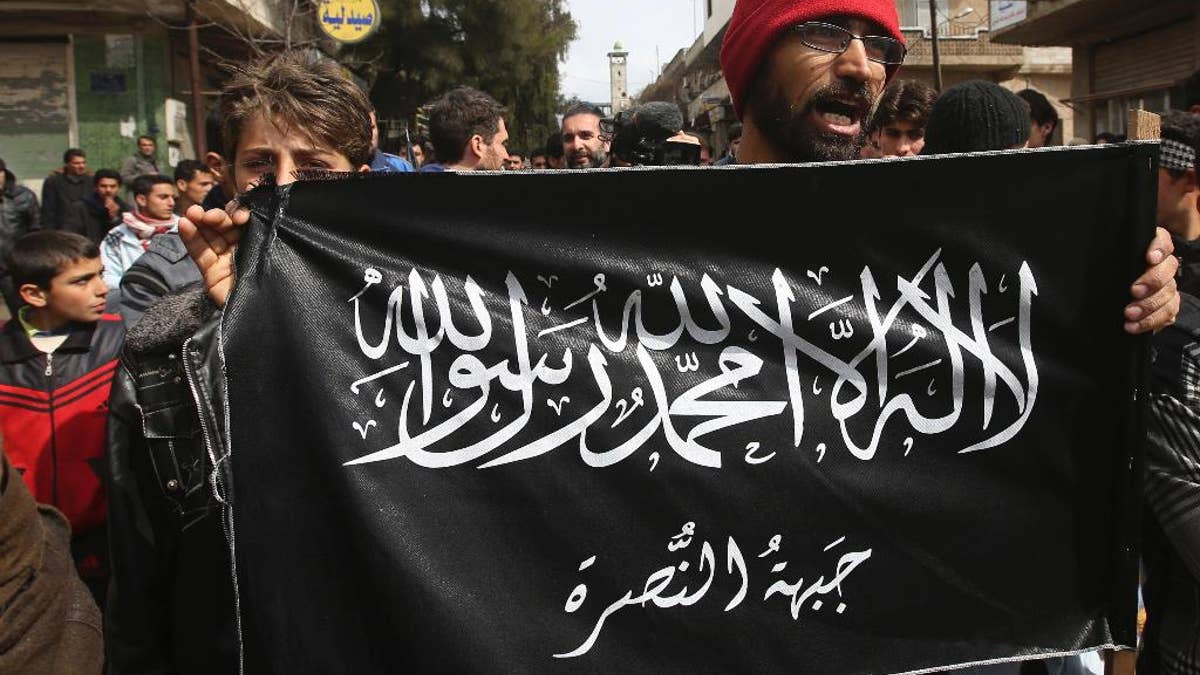
FILE- In this March 1, 2013 file photo, anti-Syrian President Bashar Assad protesters hold the Jabhat al-Nusra flag, as they shout slogans during a demonstration, at Kafranbel town, in Idlib province, northern Syria. (AP)
WASHINGTON – French and Kurdish forces in northern Iraq were attacked by an exploding drone, the Pentagon said Wednesday, adding a new worry to the wars in Iraq and Syria as militant groups learn to weaponize their store-bought drones.
Air Force Col. John Dorrian, the spokesman for the U.S.-led military coalition in Iraq, said an improvised device on a drone exploded after it was taken back to a camp near the Iraqi city of Irbil. He called it a Trojan Horse-style attack.
Two Kurds were killed in that incident on Oct. 2, according to a U.S. official, who said the drone looked like a Styrofoam model plane that was taped together in a very rudimentary style. The official said it appeared to be carrying a C-4 charge and batteries, and may have had a timer on it.
That official was not authorized to discuss the incident publicly so spoke on condition of anonymity.
France's presidential spokesman, Stephane Le Foll, said Wednesday that two French special forces were seriously injured in the explosion.
The U.S. has seen militants use a variety of improvised drones and modified drones, Dorrian said, adding, "there's nothing very high tech about them."
"They can just buy them as anybody else would," he told reporters Wednesday. "Some of those are available on Amazon."
A recently released video belonging to an al-Qaida offshoot, Jund al-Aqsa, purportedly shows a dronelanding on Syrian military barracks. In another video , small explosives purportedly dropped by the Iran-backed Shiite militant group Hezbollah target the Sunni militant group Jabhat Fatah al-Sham, formerly known as the Nusra Front, near Aleppo. The technology is not new, but the videos are the first known demonstration of these capabilities by any militant groups.
While militants with drones are not a significant military threat, Dorrian said the U.S. and its partner countries are taking it seriously.
Chris Woods, the head of the Airwars project, which tracks the international air war in Iraq, Syria and Libya, said, "there are a million ways you can weaponize drones — fire rockets, strap things in and crash them."
"This is the stuff everyone has been terrified about for years, and now it's a reality," he added.
The U.S. military official couldn't immediately authenticate the videos in question. But another former senior U.S. military official who viewed the videos said there was nothing to suggest they were fake.
A number of militant groups in the Middle East, including the Islamic State group, Jund al-Aqsa and Jabhat Fatah al-Sham, as well as Hezbollah and Hamas, have all released videos indicating that they have surveillance and reconnaissance drones. Syrian anti-government rebels and militias loyal to President Bashar Assad were also flying cheap quadcopters and hexacopters as early as 2014 to spy on one another.
The surveillance drones allowed those groups to collect data on enemy bases, battlefield positioning and weaponry and to improve targeting.
Lebanon-based Hezbollah has claimed to have armed-drone capabilities for nearly two years, but a recent video of bomblets hitting a militant camp near the Syrian town of Hama is the first known documentation.
"It's not going to change the overall balance of power in the region, but it matters by the very fact that these are things that are normally beyond the capability of insurgents or terrorists groups," said Peter Singer, author of the book "Wired for War: The Robotics Revolution and Conflict in the 21st Century," and a senior fellow at the New America Foundation.
Syrian skies are already bustling with traffic. Coalition forces have launched some 5,400 airstrikes on IS targets since September 2014. Drones account for only about 7 percent of America's total air operations in Iraq and Syria because the U.S. is "stretched really thin" with drone operations in Afghanistan, Yemen, Pakistan and elsewhere, Woods said.
Russia is also showing off its own drone capabilities — albeit somewhat primitive compared to the U.S. Last month, the Russian Defense Ministry started live online broadcast of drone footage of the besieged Syrian city of Aleppo to "provide transparency" on whether the cease-fire is being implemented.
There is no question the militant groups are outmatched in the sky. But as cells linked to the Islamic State group pop up across Europe and the United States, the real concern is the potential impact these experimental small, flying bombs could have if launched over crowded cities.
"You already see things happening in Ukraine, gangs in Mexico are using drones, and in Ireland, gangs there are using surveillance," said Wim Zwijnenburg, a security and disarmament policy adviser at Netherlands-based PAX for Peace. "Add a small amount of explosives to a small drone, and even the psychological factor is pretty significant."




















